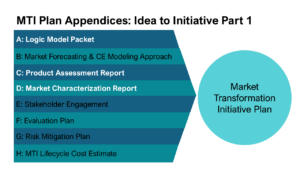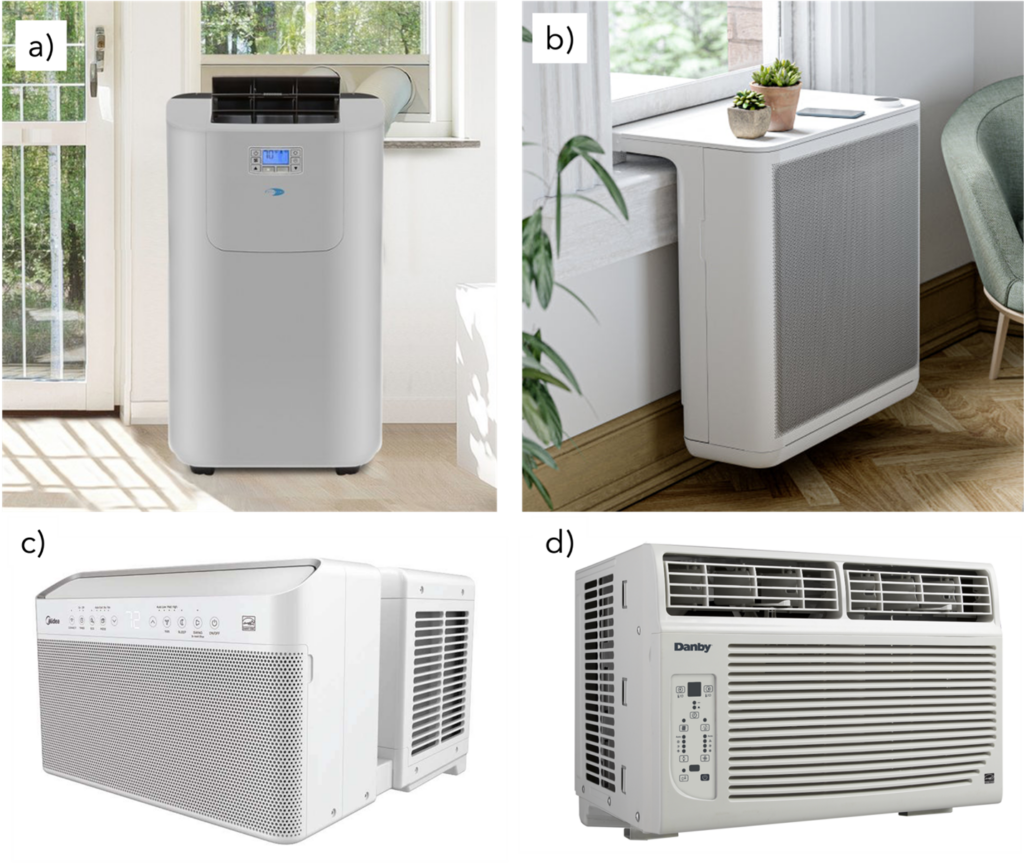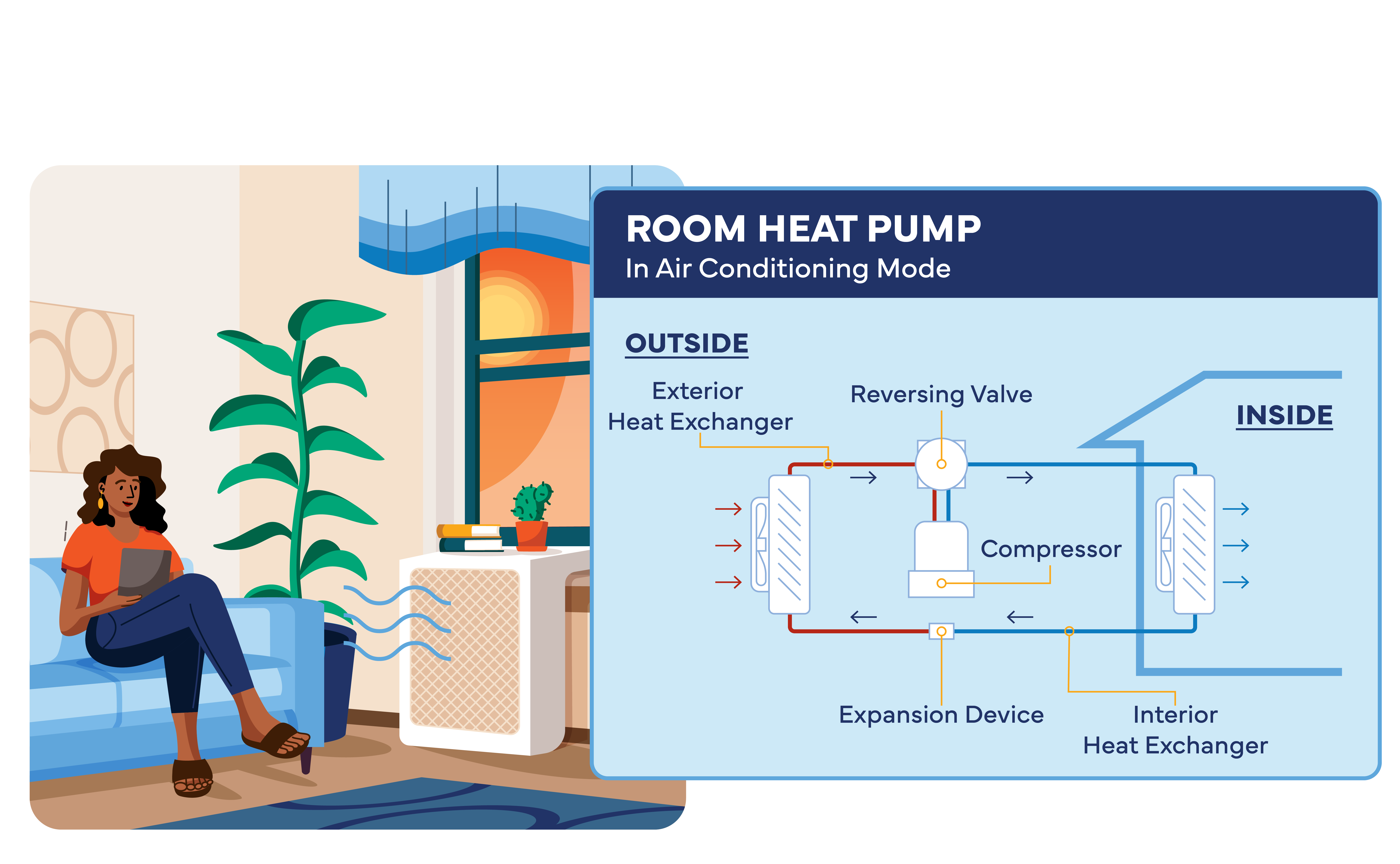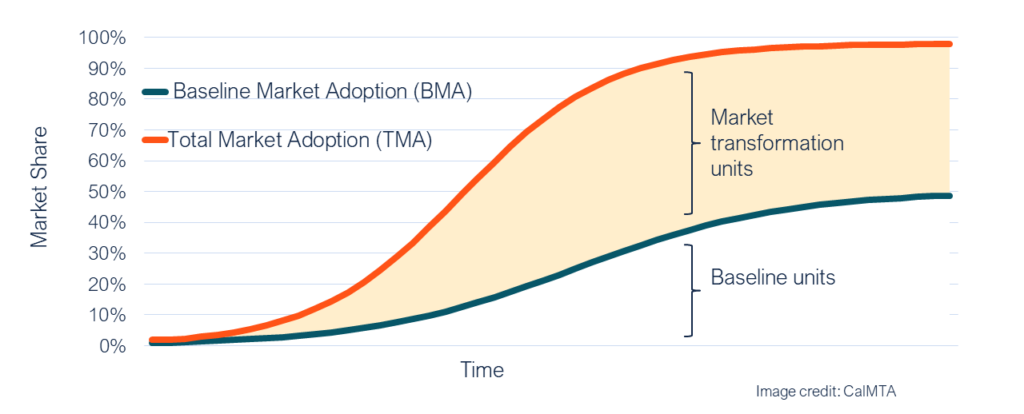Idea to Initiative: Room Heat Pumps
The Idea to Initiative educational campaign included resources to learn about the Room Heat Pumps Market Transformation Initiative (MTI). Read frequently asked questions (FAQs) and watch on demand presentations to learn about the critical aspects of the final Induction Cooking MTI Plan.

 Idea to Initiative part one focused on the market transformation theory and logic model, which represent the basis for the Room Heat Pumps MTI strategy and are a systematic and visual way of presenting understanding of the interventions necessary to remove barriers, expected outcomes of those interventions, and a pathway to the desired end state. This information corresponds to appendices A, C, and D that are being developed for the final MTI Plan, as shown right.
Idea to Initiative part one focused on the market transformation theory and logic model, which represent the basis for the Room Heat Pumps MTI strategy and are a systematic and visual way of presenting understanding of the interventions necessary to remove barriers, expected outcomes of those interventions, and a pathway to the desired end state. This information corresponds to appendices A, C, and D that are being developed for the final MTI Plan, as shown right.
FAQs: Room Heat Pumps Product Assessment
-
This MTI is titled “Room Heat Pumps” (updated from “Portable/Window Heat Pumps”) because it focuses on products within the federal appliance category “room air conditioner with reverse cycle.” This category of products includes window-mounted and portable heat pumps (listed under the federal appliance category of portable air conditioners). While we prioritize window heat pumps, we recognize that the needs of certain consumers and building types will be better met with either portable heat pumps or through-the-wall heat pumps. The images below show the four main kinds of heat pumps included in this MTI.
Four types of room heat pumps: portable heat pumps (a), saddlebag window heat pumps (b), U-shaped window heat pumps (c), and traditional window heat pumps that look like window air conditioning units (d).

-
Room heat pumps are self-contained products that provide efficient heating and cooling for small spaces, such as single rooms, modest apartments, or small homes. They offer both heating and cooling using efficient heat pump technology and can be installed without a certified technician.
Heating and cooling represent the largest energy consumption end-uses for homes in California, with more than 50% of households still using gas appliances for heating. In coordination with California’s decarbonization goals and targeted reduction in natural gas usage, room heat pumps offer an affordable and highly efficient alternative in certain applications.
-
A heat pump uses an electrical energy input to operate a vapor compression cycle, which can extract thermal energy from outside air (even when it’s quite hot or cold) and transfer it with a refrigerant to the inside of a home to warm or cool the air.

The reverse operation, where air conditioners remove heat from indoor spaces and reject it outdoors, has long been utilized to keep homes cool. Room heat pumps not only provide heat in addition to cooling, but they are also much more efficient than window air conditioning units. A heat pump’s version of this operation can be two to five times more efficient depending upon the indoor and outdoor conditions and the efficiency of the equipment.
-
Most small heat pump products on the market today are designed for mild climates; they do not have active defrost capabilities, and the compressor cutoff to shut it down is around 40°F. The New York City Housing Authority (NYCHA) Clean Heat for All Challenge aimed to change this with a cold climate specification for window heat pumps to allow efficient all-season heat pump operation in New York City. In response, manufacturers Midea and Gradient created all-weather saddlebag heat pumps designed to provide year-round heating and cooling. These products represent a leap forward in heating performance for small heat pumps with full heating capacity at 17°F and a compressor cutoff below -5°F. This advance is promising for the parts of California where winter temperatures drop significantly, although may be unnecessary for the many California consumers that live in areas with milder winters.
-
Integrating air filtration into these products could improve indoor air quality that would benefit all Californians, especially during wildfire season or on days with poor air quality. Yet this creates challenges around energy consumption and cost. Adding physical filtration media upstream of the fan can remove micron-sized physical particles from the air but will also increase the pressure drop of the system. To achieve the same airflow, the fan may have to use more energy to provide the same heating or cooling, thus reducing the heat pump’s efficiency. Depending on the system’s design, this may require a slightly larger fan to achieve the same desired flow rates.
Future lab testing and manufacturer engagement will help quantify the cost and energy penalty of high-efficiency air filtration for room heat pumps, and whether a specific intervention is required to create room heat pumps with air quality filtration that are affordable for both upfront and operating costs.
FAQs: Market Transformation Theory & Logic Models
-
Market transformation (MT) works to remove structural barriers and enact strategic interventions to create lasting change in a market. MT theory is the broad conceptualization of how best to address those barriers in order to accelerate adoption of a targeted energy efficient technology or practice. The changes created by strategic interventions grow market share and pull adoption forward in time.
Figure 1 below shows the area between the Baseline Market Adoption and Total Market Adoption S-curves. The differential is the increase resulting from MT activities that deliver cost-effective energy efficiency, greenhouse gas (GHG) reductions, or other identified benefits.
Figure 1. Market Transformation S-curve

-
MT theory works to establish clear, measurable inputs and outputs that can be assessed over time. Logic models provide a valuable roadmap to visualize the entire process of market transformation in a comprehensive chart. They depict barriers that make market adoption difficult, opportunities that can be leveraged for development, strategic interventions that will break down barriers and the resulting outputs over time. In other words, logic models map out the MT theory. CalMTA uses logic models for its initiatives to ensure coherent program organization and clearly defined, measurable outcomes for evaluation.
-
Market transformation works by removing barriers through a variety of interventions. The logic model expresses a variety of moving – and dependent – parts into a single model. A carefully conceived initiative logic provides a tool for expressing and tracking program logic and is vital to successful market transformation.
Let’s take room heat pumps as an example. Our team identified ambiguous labelling as a barrier preventing consumers from making informed choices about buying a room heat pump. Some products meant to cool or heat a small space through heat pump technology lack clear identification as such. So even if consumers are interested in the efficiency of heat pumps, they are not able tell which products to choose. Without easily understandable labeling, heat pumps will most certainly struggle to find a place in the market.
A logic model not only identifies this barrier, but also any opportunities and interventions to remove it. In this case, federal testing procedures are in development for a new ENERGY STAR label. This is an opportunity to leverage strategic interventions by working with the ENERGY STAR program’s specifications and collaborating with manufacturers to ensure proper labeling of products. The projected outcomes of those interventions are included in the logic model as well. For example, this logic model seeks ENERGY STAR adoption of a new specification within two years and revised test procedures in place within three to five years.
-
CalMTA uses a stage gate model in its Market Transformation Initiatives (MTI) strategy and program creation. A three-phase process with end-phase stage gates (shown below) helps manage program risk, maximize the use of resources, and increase transparency in our work. Learn more about the process here.

Advancement Plan approval is the stage gate that culminates Phase I: Concept Development and the plan includes a preliminary logic model. After the research and investigation described in the Advancement Plan is complete, an updated logic model is developed for inclusion in the Phase II stage gate deliverable, the MTI Plan. Click the link below to access the draft Room Heat Pump draft logic model.
Watch the Idea to Initiative Part 1 section of the Sept. 19 Market Transformation Advisory Board meeting to learn more about the Market Transformation Theory and Logic Model for the Room Heat Pumps Initiative.

Idea to Initiative Part 2 focused on Market Progress Indicators and Milestones, which are the metrics that CalMTA will use to track progress toward the expected outcomes in the Room Heat Pumps Logic Model; and confirm market adoption progress in the strategic interventions that CalMTA will employ. This information corresponds to Appendices A and F that are being developed for the final MTI Plan.
Market Progress Indicators (MPIs) and Milestones FAQs
-
Market transformation is a strategic process of intervening in a market to create lasting change. CalMTA developed a Market Transformation Initiative Evaluation Framework to lay out how we will track and evaluate the impact and cost-effectiveness of our MTIs. For each of our initiatives we develop a theory of market transformation and logic model that identifies expected short-term, medium-term, and long-term market outcomes resulting from strategic market interventions. Third-party evaluators will evaluate market progress based on the Market Progress Indicators and Milestones developed for each MTI.
-
An Outcome is the market’s response to one or more MTI’s strategic market interventions. That people buy more room heat pumps may be the end goal, but these are long-term initiatives that must be assessed over time. The end goal that doesn’t track the progress of each market intervention in the short-, mid- and long-term. Some Outcomes will be realistic in a few years, while others may take a decade to realize. For the Room Heat Pumps MTI, there are 21 Outcomes showing in the Logic Model that we would expect to see from our work.
-
MPIs are metrics that correspond with logic model outcomes and are used to track market progress.
Milestones are the specific expected quantitative or empirical achievements, including timing, that correspond with certain MPIs. While MPIs are used to track market progress, Milestones track specific achievements. Together, these metrics allow CalMTA assess MTI performance and identify areas that are performing differently than expected, so that the MTI can make timely course corrections, as appropriate.
-
CalMTA has identified several different strategic interventions necessary for transforming the market for RHPs. One of those is to influence manufacturer development of window heat pumps that meet the needs of the California market through technology challenges, demand aggregation, and ongoing manufacturer engagement. The table below shows the Outcomes we seek to achieve in the short-, medium-, and long-term time frames, along with the MPIs and Milestones we’ll use to track our impact. The Milestones will show evidence of change in the market.
Note: This is one draft example from several planned interventions. The final MPIs and Milestones may be updated in the final MTI Plan.
Outcome
Time
Market Progress Indicators
Market Milestones
Manufacturers respond to specification with product plans for California-suitable products Short (1-2 years)
Number of manufacturers engaging with CalMTA
Two manufacturers engage with CalMTA Tech Challenge by the end of 2026
Multifamily building owners value product and being to purchase it Short
(1-2 years)
Number of units covered by bulk purchase agreements
Agreements in place by the end of 2026 for multifamily building owners to purchase at least 10,000 units going forward
Availability of products that fit slider and casement windows and California-suitable temperature performance grows. Some products are available with air filtration capability.
Medium (3-5 years)
Number of Type 2 and Type 3 products for sliding and casement windows available for purchase Three RHP Type 2 or Type 3 products for sliding and casement windows become available for purchase by 2030 Medium (3-5 years)
Number of RHP products with air filtration capabilities available for purchase
Three RHP products with air filtration available by 2030
Watch the Idea to Initiative Part 2 section of the Oct. 25 Market Transformation Advisory Board meeting to learn more about the Market Progress Indicators for the Room Heat Pumps Initiative.

Idea to Initiative Part 3 focused on the Room Heat Pump MTI’s market forecasts, cost-effectiveness and Total System Benefit (TSB) calculations (the dollar-value metric that measures lifecycle energy savings, grid benefits and reliability, and GHG impacts). Part 3 information corresponds to appendices B, F, and H in the Room Heat Pump MTI Plan.
Total System Benefit and Cost-Effectiveness FAQ
-
The Total System Benefit (TSB) is the dollar-value metric that measures energy savings, grid benefits and reliability, and greenhouse gas (GHG) impacts. In 2021 the California Public Utilities Commission (CPUC) announced its intention to use this approach to evaluate the State’s energy efficiency programs to better align them with GHG emissions reduction, support for customer equity, and long-term grid stability. In the past, the CPUC’s dollar-value metrics had been based on kilowatt-hours, kilowatts, and therms, but this new TSB approach encourages programs to target high-value load reductions without directly comparing one fuel source against another (i.e., gas vs. electricity). It focuses on the benefits to the “total system” – including residents’ health and environmental concerns – rather than one particular fuel source. The CPUC officially adopted this new approach in 2024.
As California’s first Market Transformation Administrator, CalMTA is working to create energy efficiency initiatives that will transform the market. A crucial part of that work is understanding just how much a particular initiative will benefit California. While our market transformation initiatives (MTIs) seek to generate energy savings and related benefits by accelerating and increasing market adoption of energy-efficient technologies and practices, we need to evaluate those MTIs carefully.
TSB helps us measure our MTIs’ impact. Carefully estimating the energy impacts and cost-effectiveness of an MTI is crucial to understanding it and its value to Californians. Good estimates require developing a forecasting model that uses a set of inputs based on well-documented sources, methods, and assumptions. Getting the TSB right is as much about good research as it is about good math.
-
The Room Heat Pump initiative is estimated to deliver approximately $521 million in TSB from 2024-2045. Most of these benefits come from greenhouse gas emission reductions associated with product efficiency and fuel substitution, especially in later years of the MTI – after more California-appropriate RHP models become available and market adoption accelerates.

-
Not only do our initiatives need to demonstrate a beneficial TSB; they need to be cost effective. Cost-effectiveness is measured by comparing the initiative’s benefits with the costs. Various tests are used to provide different information about the impacts of the initiative from distinct vantage points. Together, these tests provide a comprehensive picture of the initiative’s cost-effectiveness:
- Total Resource Cost (TRC). This test answers the question, “Will the total costs of energy in the utility service territory decrease?” A positive TRC result indicates that the program will produce a net reduction in energy costs in the four investor-owned utility service territories over the lifetime of the program.
- Program Administrator Cost Test (PAC). This test answers the question, “Will utility bills increase?” Comparison of program administrator costs to supply-side resource costs.
- Societal Cost Test (SCT). This test answers the question, “Is California better off as a whole?”
The TRC and SCT cost tests help to answer whether efficiency is cost-effective overall. The PAC helps to answer whether the selection of measures and design of the program is balanced from the utility perspective. Collectively, these tests reveal the cost-effectiveness from the perspective of various stakeholders including program participants, utilities or California as a whole.
-
The Room Heat Pump Initiative is estimated to be cost-effective under all test perspectives.
MTI cost-effectiveness estimates, 2024-2045
TRC PAC SCT 5.46 8.29 11.2 More details about cost-effectiveness are available in Appendix B of the Room Heat Pumps MTI Plan.
-
CalMTA has forecasted the baseline market adoption (BMA) and total market adoption (TMA) of RHPs. BMA represents the expected “naturally occurring” market adoption, considering current and expected market, and regulatory and technological trends. Total Market Adoption (TMA) includes the additional adoption resulting from strategic interventions detailed in this MTI plan.
Estimated number of single-family and multifamily households adopting RHPs (in thousands)


Watch the Idea to Initiative Part 3 section of the Nov. 20 Market Transformation Advisory Board meeting to learn more about the Total System Benefit and Cost Effectiveness for the Room Heat Pumps Initiative.
Idea to Initiative: Equity FAQ
CalMTA seeks to support statewide priorities on environmental and social justice and ensure MTI outcomes reflect the needs and desires of the communities they benefit. To this end, we are working with experts in the California market on equity program development and implementation. Learn more about CalMTA’s Equity Lens.
-
CalMTA applies an equity lens in its market transformation initiative (MTI) development process so that Environmental Social Justice (ESJ) communities receive the benefits of energy efficiency investment. Strategies for ensuring that targeted products and practices are available in ESJ communities are woven throughout the MTI plans and will be proactively considered during implementation.
-
Room Heat Pumps (RHPs) are in the early phase of commercialization and there is a product gap of affordable form factors that meet the needs of California’s climate and dominant window configurations found in many multifamily and small residential homes. The Room Heat Pump MTI will address this barrier by helping to advance an affordable product option to help ESJ communities transition to heat pump technology and ensure that they are included in California’s overall heat pump goals. While certain activities will focus on ESJ communities, this MTI will work to accelerate this product’s adoption across the entire market.
-
- RHPs can be self-installed and owned by a renter or small homeowner, not requiring the need of skilled electrician or mechanical contractor.
- RHPs plug into a 120V outlet and provide an affordable, efficient decarbonization option without triggering a panel or service upgrade.
- RHPs can meet the heating, ventilation, and air-conditioning needs of a small home or apartment or for zonal heating and cooling in larger homes, offsetting use of the central system and/or reliance on inefficient supplemental devices like electric resistance heaters.
- RHPs are less expensive to operate for multifamily households that currently use electric heat.
- With the addition of air filtration features, these products will benefit ESJ communities who often suffer from higher levels of compromised indoor air quality.
-
The following strategic interventions have an equity consideration:
- Engage manufacturers on a product tech challenge for a product that meets the climate, form factor, and air filtration needs of the California market.
- Gather usage data on RHPs which will feed into the inclusion of this product as a measure for programs targeting ESJ communities. This is also an important input to developing the right messaging and guidance on these products’ appropriate installation, use, and impacts to electric bills.
- Support consumer awareness of RHP benefits and features by partnering with aligned organizations and market partners, including ESJ-focused programs and multifamily property management firms.
- Work to support inclusion and bundling of product with energy efficiency and climate resilience programs that will reduce initial product and operations cost impacts for ESJ communities.
- Encourage retailers to stock and market more affordable RHP products in ESJ communities, helping to address affordability.
- Support overall movement towards electrification rate structures that will help mitigate bill impacts for ESJ communities to transition from a gas heating system to an electric RHP.